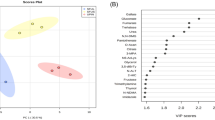Abstract
The objective of this study was to obtain the in vitro cultures of Boletus badius under controlled conditions and investigate the release of indole compounds and zinc from the mycelium of B. badius to artificial digestive juices under conditions similar to those in the human gastrointestinal tract. Biomass was obtained from cultures grown using both only the Oddoux medium as well as the same medium with added zinc hydroaspartate and zinc sulfate. The release of 5-hydroxy-L-tryptophan, L-tryptophan, and serotonin from the B. badius biomass extracts to the artificial digestive juices was determined. Differential pulse anodic stripping voltammetry was used to demonstrate that zinc is released from each of the extracted materials. The total amount of zinc in the materials under study was estimated to be between 7.12 and 44.15 mg/100 g dry weight. It was demonstrated that in vitro cultures of B. badius grown using appropriately selected media may supplement zinc and indole compounds.
Similar content being viewed by others
References
Doğan HH, Sanda MA, Uyanöz R, Öztürk C, Çetin Ü. Contents of metals in some wild mushrooms. Biol. Trace Elem. Res. 110: 79–93 (2006)
Kalač P. Chemical composition and nutritional value of European species of wild growing mushrooms: A review. Food Chem. 113: 9–16 (2009)
Wasser SP, Weis A. Therapeutic effects of substances occurring in higher Basidiomycetes mushroom: A modern perspective. Crit. Rev. Immunol. 19: 65–69 (1999)
Zaidman BZ, Yassin M, Mahajana J, Wasser SP. Medicinal mushroom modulators of molecular targets as cancer therapeutic. Appl. Microbiol. Biot. 67: 453–468 (2005)
Barros L, Cruz T, Baptista P, Estevinho LM, Ferreira ICFR. Wild and commercial mushrooms as source of nutrients and nutraceuticals. Food Chem. Toxicol. 46: 2742–2747 (2008)
Scalbert A, Manach C, Morand C, Remesy C, Jimenez J. Dietary polyphenols and the prevention of diseases. Crit. Rev. Food Sci. 45: 287–306 (2005)
Singh M, Arseneault M, Sanderson T, Murthy V, Ramassamy C. Challenges for research on polyphenols from foods in Alzheimer’s disease: Bioavability, metabolism and cellular and molecular mechanism. J. Agr. Food Chem. 56: 4855–4873 (2008)
Vermerris W, Nicholson R. Phenolic compounds and their effects on human health. pp. 235255. In: Phenolic Compound Biochemistry. Vermerris W, Nicholson R (eds). Springer Science+Business Media BV, Dordrecht, Netherlands (2008)
Barros L, Dueñas M, Ferreira ICRF, Baptista P, Santos-Buelga C. Phenolic acids determination by HPLC-DAD-ESI/MS in sixteen different Portuguese wild mushrooms species. Food Chem. Toxicol. 47: 1076–1079 (2009)
Muszyńska B, Sułkowska-Ziaja K, Ekiert H. Phenolic acids in selected edible Basidomycota species: Armillaria mellea, Boletus badius, Boletus edulis, Cantharellus cibarius, Lactarius deliciosus, and Pleurotus ostreatus. Acta Sci. Pol.-Hortoru 12: 107–116 (2013)
Reis FS. Antioxidant properties and phenolic profile of the most widely appreciated cultivated mushrooms: A comparative study between in vivo and in vitro samples. Food Chem. Toxicol. 50: 1201–1207 (2012)
Elmastas M, Isildak O, Turkekul I, Temur N. Determination of antioxidant activity and compounds in wild edible mushrooms. J. Food Compos. Anal. 20: 337–345 (2007)
Muszyńska B, Sułkowska-Ziaja K, Lojewski M, Opoka W, Zajac M, Rojowski J. Edible mushrooms in prophylaxis and treatment of human diseases. Med. Inter. Rev. 101: 170–183 (2013)
Andreini C, Bertini I. A bioinformatics view of zinc enzymes. J. Inorg. Biochem. 111: 150–156 (2012)
Kuljeet K, Rajiv G, Shubhini AS, Shailendra KS. Zinc: The metal of life. Compr. Rev. Food Sci. F. 13: 35–376 (2014)
Knudsen H, Vesterholt J. In: Funga Nordica: Agaricoid, boletoid and cyphelloid genera. Knudsen H, Vesterholt J (eds). Nordsvamp, Copenhagen, Denmark (2008)
Oddoux L. Recherches sur les mycéliums secondaires des Homobasidiés en culture pure. In: Imprimerie de Trevoux, Lyon. pp. 9–20 (1957)
Arvidson K, Johasson EG. Galvanic current between dental alloys in vitro. Scand. J. Dent. Res. 93: 467–473 (1985)
Polish Pharmacopeia. Ed X, PTFarm, Warszawa, Poland. p. 646 (2014)
Zajac M, Muszyńska B, Kała K, Sikora A, Opoka W. Popular species of edible mushrooms as a good source of zinc released to artificial digestive juices. J. Physiol. Pharmacol. 66: 763–769 (2015)
Muszyńska B, Ekiert H, Kwiecien I, Maoelanka A, Zodi R, Beerhues L. Comparative analysis of therapeutically important indole compounds in in vitro cultures of Hypericum perforatum cultivars by HPLC and TLC analysis coupled with densitometric detection. Nat. Prod. Commun. 9: 1437–1440 (2014)
Validation and analytical procedures: Text and methodology. Available from: http://www.ich.org/fileadmin/Public_Web_Site/ICH_Products/Guidelines/ Quality/Q2_R1/Step4/Q2_R1__Guideline.pdf. Accessed Nov. 6, 2015
Sułkowska-Ziaja K, Muszyńska B, Motyl P, Ekiert H, Pasko P. Phenolic compounds and antioxidant activity in some species of polyporoid mushrooms from Poland. Int. J. Med. Mushrooms 14: 385–393 (2012)
Muszyńska B, Sułkowska-Ziaja K, Ekiert H. Indole compounds in fruiting bodies of some selected Macromycetes species and in their mycelia cultured in vitro. Pharmazie 64: 479–480 (2009)
Muszyńska B, Sułkowska-Ziaja K, Ekiert H. Analysis of indole compounds in methanolic extracts from the fruiting bodies of Cantharellus cibarius (the Chanterelle) and from the mycelium of this species cultured in vitro. J. Food Sci. Tech. Mys. 50: 1233–1237 (2013)
Muszyńska B, Sułkowska-Ziaja K. Analysis of indole compounds in edible Basidiomycota species after thermal processing. Food Chem. 132: 455–459 (2012)
Muszyńska B, Sułkowska-Ziaja K, Ekiert H. An antioxidant in fruiting bodies and in mycelia from in vitro cultures of Calocera viscosa (Basidiomycota)-preliminary results. Acta Pol. Pharm. 69: 135–138 (2012)
Muszyńska B, Kała K, Sułkowska-Ziaja K, Gawel K, Zajac M, Opoka W. Determination of indole compounds released from selected edible mushrooms and their biomass to artificial stomach juice. LWT-Food Sci. Technol. 62: 27–31 (2015)
Reczyński W, Muszyńska B, Opoka W, Smalec A, Sułkowska-Ziaja K. Comparative study of metals accumulation in cultured in vitro mycelium and natural grown fruiting bodies of Boletus badius and Cantharellus cibarius. Biol. Trace Elem. Res. 153: 355–359 (2013)
Author information
Authors and Affiliations
Corresponding author
Rights and permissions
About this article
Cite this article
Kała, K., Maślanka, A., Sułkowska-Ziaja, K. et al. In vitro culture of Boletus badius as a source of indole compounds and zinc released in artificial digestive juices. Food Sci Biotechnol 25, 829–837 (2016). https://doi.org/10.1007/s10068-016-0138-z
Received:
Revised:
Accepted:
Published:
Issue Date:
DOI: https://doi.org/10.1007/s10068-016-0138-z




